In the vast landscape of acting methodologies, Constantin Stanislavski’s system stands as a towering monument that has fundamentally transformed how actors approach their craft.
The Russian theater practitioner’s revolutionary techniques have become the bedrock of modern acting, influencing generations of performers since their inception in the early 20th century.
This comprehensive exploration delves into the essential elements of the Stanislavski Method, offering both novice and experienced actors practical insights into mastering these time-tested techniques.
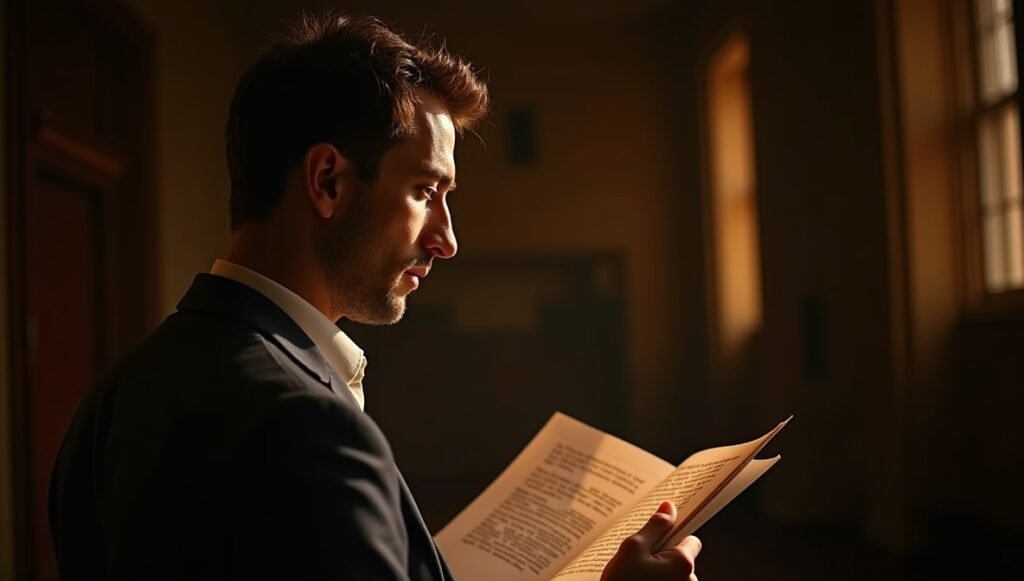
The Genesis of a Revolution
When Constantin Stanislavski founded the Moscow Art Theatre in 1898 alongside Vladimir Nemirovich-Danchenko, little did the theatrical world know that this collaboration would spark a seismic shift in acting methodology. Stanislavski’s dissatisfaction with the melodramatic and artificial acting styles prevalent during his era drove him to develop a system that would enable actors to create authentic, believable performances that resonated with truth.
Born in 1863 to a wealthy Russian family, Stanislavski enjoyed theatrical privileges from an early age, attending performances at the Bolshoi and Maly Theatres. His journey from amateur actor to revolutionary theorist stemmed from a profound desire to understand how great actors achieved moments of genuine inspiration. Rather than relying on sporadic flashes of brilliance, Stanislavski sought to establish a replicable methodology that would consistently produce authentic performances.
The system he developed was not static but rather evolved throughout his lifetime. His work spans several seminal texts, including “An Actor Prepares,” “Building a Character,” and “Creating a Role,” which collectively outline his comprehensive approach to the actor’s craft. Through decades of experimentation at the Moscow Art Theatre, Stanislavski refined techniques that would ultimately transform how actors prepare for and embody their roles.
The Fundamental Philosophy
At its core, the Stanislavski Method rests on a fundamental principle: believability. Unlike the theatrical traditions that preceded him, which often emphasized external techniques and presentational performances, Stanislavski insisted that actors must experience genuine thoughts and emotions analogous to those of their characters. This revolutionary concept—that an actor should not merely represent but rather live as the character onstage—forms the philosophical foundation of his entire system.
Stanislavski’s approach rejected the notion of acting as mere imitation or technical skill. Instead, he conceptualized performance as a psychophysical process involving the actor’s complete instrument—mind, body, and spirit. His methods aimed to create a dynamic harmony between the actor’s internal psychological state and external physical expression, what he termed the “art of experiencing” rather than the “art of representation.”
This philosophical shift from external to internal, from mechanical to organic, continues to resonate with contemporary acting practices worldwide. Indeed, whether actors study at prestigious institutions like Juilliard or The Actors Studio, they engage with principles that trace directly back to Stanislavski’s revolutionary vision.

The Toolbox: Essential Stanislavski Techniques
1. Given Circumstances
The foundation of any character analysis begins with what Stanislavski termed the “given circumstances.” These encompass all the contextual information provided by the playwright: the historical period, geographical location, social environment, immediate situation, and relationships between characters. Rather than viewing these as merely background information, Stanislavski considered them vital creative stimuli that shape a character’s psychology and behavior.
To effectively employ given circumstances, actors must:
- Thoroughly analyze the text for explicit and implicit information
- Research historical, social, and cultural contexts relevant to the play
- Understand how external conditions influence their character’s perspective
- Allow these circumstances to inform every choice they make onstage
The director Elia Kazan, who studied with Stanislavski disciples at the Group Theatre, emphasized that “an actor without a thorough understanding of given circumstances is like a navigator without coordinates.” This analogy highlights the orientational value of given circumstances—they provide the actor with essential navigational tools for the journey into character.
When rehearsing Anton Chekhov’s “The Cherry Orchard,” for instance, actors would benefit from understanding the socioeconomic changes in late 19th-century Russia, the declining aristocracy, the emergence of the merchant class, and the abolition of serfdom. These given circumstances profoundly influence characters like Madame Ranevskaya and Lopakhin, informing their worldviews, motivations, and interactions.
2. Emotional Memory (Affective Memory)
Perhaps one of Stanislavski’s most discussed techniques is emotional memory, sometimes called affective memory. This approach involves actors drawing upon their personal experiences to access genuine emotions analogous to those required by their characters. By recalling the sensory details associated with significant emotional events from their own lives, actors can stimulate authentic emotional responses during performance.
The process typically unfolds as follows:
- Identify the emotional state required for a particular scene
- Recall a personal experience that evoked similar feelings
- Focus on sensory details of that memory (sights, sounds, smells, textures)
- Allow the emotional response to emerge organically
- Transfer this emotional state to the character’s situation
This technique requires considerable psychological introspection and emotional vulnerability. Stanislavski later refined this approach, cautioning against excessive dwelling on potentially traumatic memories. He shifted toward emphasizing imagination over memory, particularly in his later work.
It’s worth noting that while emotional memory remains influential, it has been both embraced and contested by subsequent acting theorists. Lee Strasberg emphasized and expanded this aspect of Stanislavski’s work in his development of Method Acting at the Actors Studio, while other Stanislavski disciples like Stella Adler and Sanford Meisner placed greater emphasis on imagination and action.
3. The Magic If
Stanislavski recognized the transformative power of imagination in the actor’s process, developing a technique he called “the magic if.” This deceptively simple but profoundly powerful tool involves actors asking themselves: “What would I do if I were in this character’s situation?” By framing character development through this hypothetical lens, actors can access authentic responses while maintaining psychological safety.
The magic if works by:
- Bridging the gap between the actor’s reality and the character’s circumstances
- Stimulating truthful responses to fictional situations
- Engaging the actor’s creative imagination
- Creating a sense of immediacy and personal investment
This technique acknowledges that while actors cannot literally become their characters, they can respond truthfully to imagined circumstances. As Stanislavski wrote, “The actor creates his model in his imagination, and then, just as does the painter, he takes every feature of it and translates it into his own person.”
The magic if proves particularly valuable when working with material distant from an actor’s personal experience. When portraying Lady Macbeth, for instance, contemporary actresses need not have experienced murderous ambition, but they can truthfully explore how they would respond if placed in her circumstances, dealing with her relationships, desires, and conflicts.
4. Units and Objectives
Stanislavski’s approach to script analysis revolutionized how actors understand dramatic structure. He introduced the concept of breaking down scripts into manageable units (sometimes called “bits”) and identifying specific objectives within each unit. This analytical framework gives actors clear, actionable goals that drive their performance.
The process involves:
- Dividing the script into logical segments or units
- Identifying the character’s objective (what they want) in each unit
- Formulating these objectives as active, transitive verbs (e.g., “to persuade,” “to comfort,” “to challenge”)
- Recognizing how these smaller objectives serve the character’s super-objective (overarching goal)
- Understanding how obstacles create dramatic tension
Stanislavski insisted that objectives should always be expressed as verbs rather than nouns, emphasizing the active nature of dramatic action. Instead of saying “I want love,” an actor would specify “I want to win her affection” or “I want to make him jealous.” This specificity provides actors with playable actions rather than abstract concepts.
The super-objective represents the character’s throughline—their fundamental desire that motivates all their actions throughout the play. For instance, in “A Streetcar Named Desire,” Blanche DuBois might have the super-objective “to find security and belonging,” which informs her behavior in every scene.
5. Physical Actions and Psychophysical Connection
As his system evolved, Stanislavski increasingly emphasized the interconnectedness of physical and psychological aspects of performance. His Method of Physical Actions suggested that truthful physical behavior could stimulate authentic emotional responses—a reversal of his earlier emphasis on internal processes leading to external expression.
This approach recognizes that:
- Physical actions can trigger corresponding emotional states
- Detailed attention to authentic behavior creates believability
- Concrete physical tasks provide actors with tangible work when emotions prove elusive
- The body and mind function as an integrated system
Stanislavski observed that actors often struggled when focusing exclusively on psychological states, becoming self-conscious or forced. By concentrating instead on executing truthful physical actions appropriate to the character and situation, actors could access authentic emotions indirectly.
This aspect of Stanislavski’s work significantly influenced subsequent practitioners like Jerzy Grotowski and Rudolf Laban, who further explored the psychophysical dimensions of acting. It remains particularly relevant for contemporary screen actors, who must often perform emotional scenes repeatedly without losing authenticity.
6. Concentration and Attention
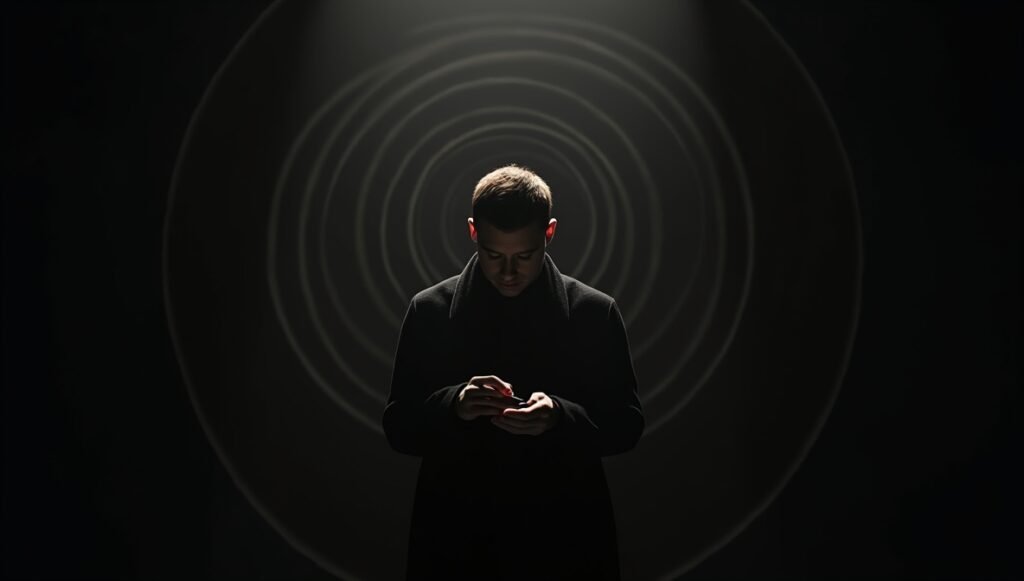
Recognizing that an actor’s attention powerfully shapes their performance, Stanislavski developed techniques to cultivate focused concentration. He introduced the concept of “circles of attention,” which help actors direct their focus appropriately despite the distractions inherent to performance environments.
These circles of attention include:
- The small circle: focusing on oneself or immediate objects
- The medium circle: encompassing scene partners and the immediate environment
- The large circle: extending to the entire stage or set
- The fourth circle: including the audience (though in naturalistic performance, this awareness remains implicit)
By consciously controlling their focus, actors can achieve what Stanislavski called “public solitude”—the ability to behave truthfully and intimately despite being observed by an audience. This skill proves essential for maintaining believability, particularly in close-up film work where cameras capture subtle shifts in attention.
Practical exercises to develop this capacity include:
- Object focus drills, requiring sustained attention to specific objects
- Partner observation exercises that cultivate detailed awareness
- Environmental attention practices that expand perceptual capacity
- Meditation techniques that strengthen concentration
Contemporary acting teacher Ivana Chubbuck emphasizes that “an actor’s attention determines the audience’s attention.” This observation highlights the directorial function of an actor’s focus—it guides the viewer’s experience of the performance.
7. Relaxation and Tension Release
Stanislavski recognized that physical tension interferes with expressive capacity and emotional availability. Consequently, he developed systematic approaches to identifying and releasing unnecessary muscular tension while performing.
His relaxation techniques emphasize:
- Body awareness and scanning for areas of tension
- Systematic release of muscle groups
- Maintaining appropriate energy while eliminating counterproductive tension
- Establishing a relaxed readiness for action
These practices have been further developed by subsequent movement specialists like F.M. Alexander and Moshe Feldenkrais, whose methods complement Stanislavski’s approach to psychophysical integration.
Modern neuroscience affirms Stanislavski’s intuitive understanding of the tension-emotion relationship. Research demonstrates that physical tension can trigger stress responses that inhibit access to certain emotional states and creative impulses. By cultivating relaxed alertness, actors create optimal conditions for authentic performance.
8. Communion and Adaptation
Stanislavski placed tremendous emphasis on the relational aspects of acting, developing techniques to foster genuine connection between performers. He used the term “communion” to describe the authentic exchange of energy, attention, and response between actors.
Effective communion requires:
- Genuine listening rather than merely waiting to speak
- Responsive rather than predetermined behavior
- Moment-to-moment awareness of subtle changes in scene partners
- The ability to adapt spontaneously to unexpected variations
The related concept of adaptation refers to the actor’s capacity to adjust their performance in response to changing circumstances, maintaining truthfulness even when confronted with the unexpected. This flexibility allows performances to remain fresh and alive rather than mechanically reproduced.
These principles profoundly influenced the development of improvisational techniques by practitioners like Viola Spolin and Keith Johnstone. They also form the foundation of contemporary screen acting approaches that value authentic reaction over prepared indication.
Integration: From Technique to Artistry
While understanding individual techniques provides essential foundations, true mastery of the Stanislavski Method involves integrating these elements into a cohesive approach. This integration allows actors to transcend technical execution and achieve what Stanislavski called “the creative state”—a condition of inspired yet disciplined artistry.
The integration process typically follows this progression:
Analysis and Preparation
Before rehearsals begin, actors undertake thorough text analysis, identifying:
- Given circumstances that establish context
- Character objectives and super-objectives
- Relationships and their dynamics
- The play’s structure and the character’s arc
- Historical, social, and cultural contexts
This analytical groundwork provides the intellectual foundation for subsequent exploratory work. Rather than limiting creativity, thorough preparation establishes parameters that focus and deepen the actor’s creative process.
Exploratory Rehearsal
With analytical foundations established, actors enter an exploratory phase characterized by:
- Experimentation with physical actions and behaviors
- Application of the magic if to stimulate truthful responses
- Exploration of varied approaches to objectives
- Development of sensory and emotional connections to material
- Discovery through improvisation and exercises
During this phase, actors remain open to unexpected discoveries while guided by their analytical understanding. This balance between structure and spontaneity characterizes Stanislavski’s approach at its best.
Refinement and Embodiment
As performance approaches, actors refine their work through:
- Precision in physical actions and vocal expression
- Internalization of character psychology
- Establishment of playable moment-to-moment actions
- Integration of technical elements (costume, props, set)
- Development of consistent yet living repeatability
This refinement phase transforms conscious technique into embodied performance. Ideally, the mechanical aspects of the method recede from conscious attention, allowing the actor to perform with both spontaneity and precision.
Performance Integration
In performance, the actor ideally achieves:
- Presence and responsiveness in the moment
- Balance between preparation and spontaneity
- Connection with scene partners and audience
- Access to the “creative state” where technique serves artistry
- The ability to recreate truthful experience reliably
This final integration represents the culmination of Stanislavski’s vision—performances that combine rigorous technique with artistic inspiration, structured preparation with spontaneous life.
Practical Applications Across Media
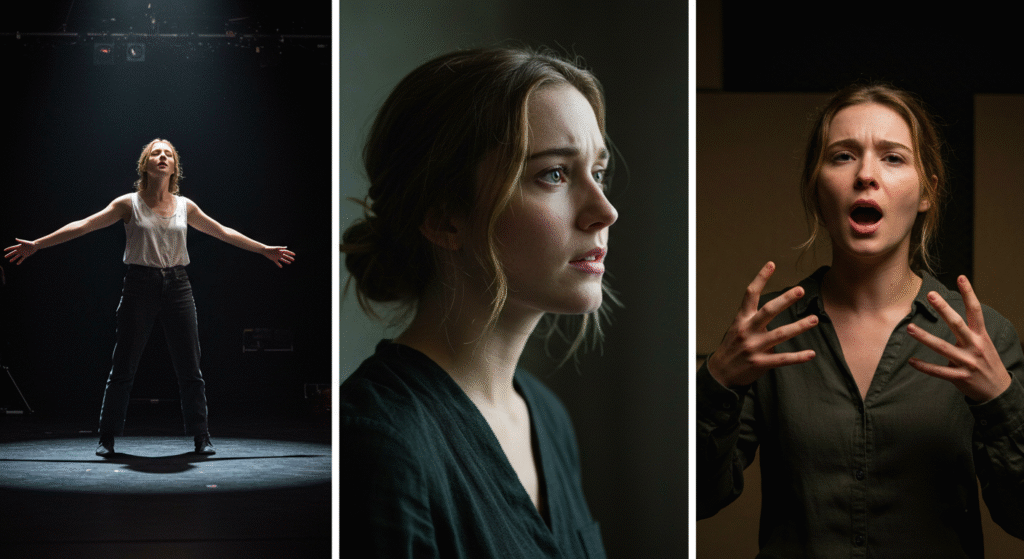
While developed primarily for theatrical performance, Stanislavski’s techniques have proven remarkably adaptable across performance media. Let’s examine how these principles translate to different contexts:
Stage Performance
In theatrical settings, Stanislavski’s techniques manifest through:
- Full-bodied expressiveness required by the distance between performer and audience
- Sustained character embodiment throughout a complete narrative arc
- The challenge of truthful repetition over extended performance runs
- The absence of editing, requiring seamless integration of all performance elements
- The unique communion between live performers and audience
The theatrical origin of Stanislavski’s methods means they translate most directly to stage work, though even here, different theatrical styles may emphasize different aspects of his system.
Film and Television Acting
When adapted to screen performance, Stanislavski’s approach accommodates:
- The intimacy of close-up work, which reveals subtle thoughts and emotions
- Fragmented shooting schedules requiring emotional access on demand
- The collaborative relationship between actor and camera
- The technical requirements of hitting marks and accommodating shot compositions
- The absence of chronological performance, necessitating strong preparation and imagination
Many screen actors find that Stanislavski’s emphasis on truthful behavior rather than projected emotion serves them particularly well in film work, where cameras capture even microscopic inauthenticity.
Voice Acting and Motion Capture
In contemporary performance contexts, Stanislavski’s principles extend to:
- Voice performance for animation and gaming, where physical expression channels into vocal behavior
- Motion capture work, which requires imaginative engagement with absent scene elements
- Virtual production environments where actors interact with minimal physical references
- Performance for interactive media, requiring flexible responses to variable narratives
Even in these technologically mediated contexts, the fundamental principles of truthful objective-driven behavior remain applicable, albeit with adaptive modifications.
Common Misconceptions and Challenges
Despite its widespread influence, the Stanislavski Method often suffers from misunderstanding and misapplication. Addressing these misconceptions helps actors engage more productively with the system.
Misconception 1: Method Acting Equals Emotional Excess
Perhaps the most pervasive misconception equates Stanislavski’s approach with emotional indulgence or psychological self-torture. This misunderstanding stems partly from the publicized extremes of certain Method actors who adopted controversial techniques like remaining in character off-stage or subjecting themselves to grueling conditions in pursuit of authenticity.
Stanislavski himself advocated balance and psychological well-being, cautioning against excessive emotional identification that might damage the actor’s instrument. His later work increasingly emphasized physical actions as pathways to emotional truth, rather than direct emotional recall.
Misconception 2: The System as Rigid Doctrine
Another common misconception treats Stanislavski’s methods as inflexible rules rather than adaptable principles. In reality, Stanislavski continuously revised his approaches throughout his lifetime, and he encouraged actors to develop personalized applications of his concepts.
The system works best when understood as a flexible framework rather than rigid doctrine. Different actors naturally gravitate toward different aspects of the method based on their individual processes and the specific demands of various roles.
Misconception 3: Universality of Application
While tremendously versatile, Stanislavski’s methods were developed primarily for realistic drama. Actors working in stylized forms like commedia dell’arte, classical Greek tragedy, or certain experimental genres may need to supplement Stanislavski’s techniques with approaches specifically designed for these theatrical languages.
Even within realistic performance, different cultural traditions may require adaptations to Stanislavski’s predominantly European perspective. Contemporary acting pedagogues increasingly integrate diverse cultural performance traditions alongside Stanislavski-derived techniques.
Challenge: Integration of Technique and Spontaneity
Perhaps the greatest challenge for actors working with Stanislavski’s methods involves transcending technique to achieve genuine spontaneity. When applied mechanically, these approaches can produce intellectualized performances lacking vitality. The true mastery of Stanislavski’s system involves internalizing techniques so thoroughly that they operate below conscious awareness during performance.
As Stanislavski himself noted, “When you’re in front of an audience, you must forget all your knowledge of the System.” This paradoxical instruction highlights the ultimate goal—not the perfect application of technique, but the achievement of authentic artistic expression supported by technique.
Contemporary Evolutions of Stanislavski’s Work
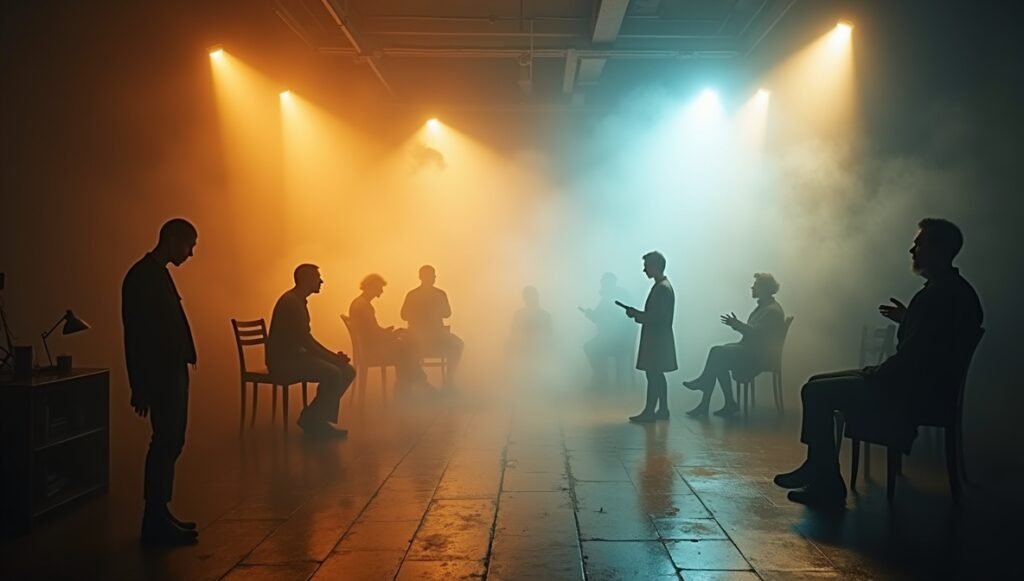
Like any influential methodology, Stanislavski’s system has spawned numerous interpretations, adaptations, and evolutions. Major developments include:
The American Method
Lee Strasberg’s interpretation of Stanislavski’s work emphasized emotional memory techniques, developing extensive exercises to help actors access and utilize personal experiences. The Actors Studio, which Strasberg directed from 1951 until his death in 1982, became the epicenter of this approach, influencing performers like Marlon Brando, Marilyn Monroe, Al Pacino, and Robert De Niro.
Strasberg’s version of the Method particularly suited the psychological realism dominant in mid-20th century American cinema and theater. However, it represents just one interpretation of Stanislavski’s multifaceted system, one that some critics argue overemphasizes emotional aspects at the expense of physical and objective-driven work.
The Adler Approach
Stella Adler, who studied directly with Stanislavski in Paris in 1934, developed an approach emphasizing imagination over personal experience. After Stanislavski told her he had moved away from emotional memory techniques, Adler returned to America and established a methodology focusing on:
- Detailed script analysis
- Historical and social research
- Imaginative engagement with circumstances
- The importance of actions over emotions
- Understanding social behavior and status
Adler’s interpretation, which influenced actors like Marlon Brando, Robert De Niro, and Mark Ruffalo, aligns closely with Stanislavski’s later work, which emphasized the Method of Physical Actions.
The Meisner Technique
Sanford Meisner developed another significant interpretation of Stanislavski’s principles, creating a progressive training methodology centered on:
- The reality of doing rather than pretending
- Moment-to-moment truthfulness
- Responsiveness to scene partners
- Repetition exercises to develop authentic listening
- Emotional preparation techniques that create conditions for genuine response
Meisner’s famous dictum that “acting is living truthfully under imaginary circumstances” distills Stanislavski’s complex system into a straightforward yet profound principle. His approach has influenced performers ranging from Gregory Peck and Diane Keaton to James Franco and Naomi Watts.
Psychophysical Approaches
Building on Stanislavski’s later emphasis on physical actions, practitioners like Michael Chekhov, Jerzy Grotowski, and Tadashi Suzuki developed training methodologies that approach character through physical embodiment rather than psychological analysis.
These approaches often incorporate:
- Systematic body training techniques
- Exploration of archetypal movements and gestures
- Psychophysical exercises connecting imagination to physical expression
- Work with energy, rhythm, and spatial dynamics
- Development of “physical imagination” beyond psychological realism
These evolutions demonstrate the adaptability of Stanislavski’s foundational principles while highlighting the system’s capacity for growth and transformation.
Practical Exercises for Skill Development
Mastering Stanislavski’s techniques requires consistent practice. The following exercises, derived from his system and its subsequent developments, provide practical pathways to skill acquisition:
Exercise 1: Sense Memory
This foundational exercise develops the sensory imagination essential for believable performance:
- Select an everyday object (e.g., a cup, brush, or fruit)
- Examine it thoroughly, noting every sensory detail
- Set the object aside and recreate the experience of interacting with it
- Work progressively through each sense—touch, sight, smell, taste, sound
- Gradually increase the complexity of objects and interactions
Practice daily for 10-15 minutes, focusing on sensory precision rather than emotional response. This exercise develops the actor’s capacity to engage truthfully with imaginary objects and environments.
Exercise 2: Objective Practice
This exercise strengthens the actor’s ability to pursue clear objectives:
- Select a simple action (e.g., opening a window)
- Perform this action with different objectives (to let in fresh air, to escape danger, to spy on someone)
- Allow each objective to transform how you execute the physical action
- Gradually increase objective complexity and emotional stakes
- Practice transitioning between objectives within continuous action
This exercise demonstrates how intentions reshape behavior, developing the actor’s capacity to physicalizing psychological drives.
Exercise 3: Given Circumstances Exploration
This improvisation-based exercise develops responsiveness to contextual factors:
- Establish a simple scenario with a partner
- Perform the scene under different given circumstances (changing period, relationship dynamic, preceding event, etc.)
- Commit fully to each variation without discussing adjustments beforehand
- Reflect afterward on how the circumstances transformed behavior
- Progress toward incorporating multiple changing circumstances simultaneously
This exercise cultivates adaptability and contextual awareness, essential for truthful character embodiment.
Exercise 4: Communion Training
This partner exercise develops relational authenticity:
- Sit facing a partner in silence for one minute
- Without speaking, attempt to communicate specific thoughts or feelings
- Notice subtle shifts in your partner’s expression and energy
- Graduate to communicating while speaking simple dialogue
- Progress to script work, maintaining this heightened awareness
This exercise develops the nonverbal attunement crucial for believable interaction, counteracting the tendency toward self-absorbed performance.
Exercise 5: Physical Action Sequence
This exercise implements Stanislavski’s later emphasis on physical behavior:
- Break down a character action into detailed physical components
- Execute each component with precision and purpose
- Connect emotional impulses to specific physical moments
- Gradually increase speed while maintaining precision
- Ultimately perform the sequence as an integrated whole
This exercise develops the psychophysical coordination essential for embodied performance, helping actors transcend the mind-body divide that can create artificial performances.
The Contemporary Relevance of Stanislavski

Over a century after its development, Stanislavski’s system remains foundational to actor training worldwide. This enduring relevance stems from several factors:
Psychological Understanding
Stanislavski’s work anticipated many insights of modern psychology, particularly regarding:
- The connection between physical behavior and emotional states
- The role of attention in shaping experience
- The importance of specific objectives in motivating behavior
- The influence of environment and relationships on individual psychology
His intuitive understanding of these principles has been validated by subsequent psychological and neuroscientific research, reinforcing the system’s empirical foundations.
Adaptability Across Media
While developed for theatrical performance, Stanislavski’s principles have proven remarkably adaptable to emerging media forms, including:
- Film and television performance
- Voice acting and motion capture
- Interactive and digital performance contexts
- Contemporary devised and collaborative theatrical forms
This adaptability suggests that Stanislavski identified fundamental principles of human behavior rather than merely technical approaches to a specific performance context.
Bridge Between Tradition and Innovation
Stanislavski’s methods connect classical theatrical traditions with contemporary performance practices. His system offers:
- Respect for dramatic literature and textual analysis
- Value for inspired spontaneity and presence
- Balance between technical precision and artistic freedom
- Integration of intellectual understanding and embodied expression
This balanced approach appeals to both traditionalists and innovators, allowing for continued evolution while maintaining core principles.
Conclusion: The Living Legacy
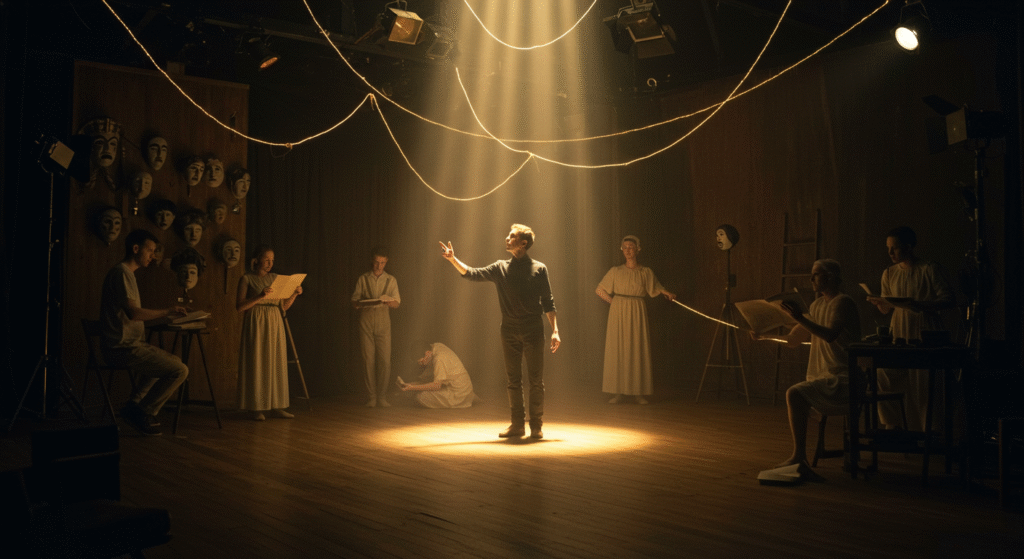
Constantin Stanislavski’s revolutionary approach to acting fundamentally transformed performance in the 20th century and continues to shape theatrical practice in the 21st. His insistence on truthfulness, his integration of psychological understanding with physical technique, and his systematic approach to actor training established foundations that support diverse performance traditions worldwide.
The enduring value of Stanislavski’s work lies not in rigid adherence to specific techniques but in the philosophical principles underlying his system: the pursuit of authenticity, the integration of mind and body, the importance of specific action, and the transformative power of imagination. These principles transcend particular methodologies, providing essential guidance for actors across styles, cultures, and media.
As theater director Peter Brook observed, “Stanislavski’s great discovery can be simply expressed: the life of a character should not be an imitation, nor should it be the fruit of an actor’s fantasy—it should be an independent reality, fully observed from all possible viewpoints.” This observation captures the essence of Stanislavski’s contribution—he provided actors with practical tools to create that “independent reality,” transforming acting from skilled pretense into embodied truth.
For contemporary actors navigating diverse performance contexts, Stanislavski’s methods offer not restrictive rules but liberating frameworks. By mastering these foundational techniques while remaining open to continued evolution, performers honor Stanislavski’s legacy not through dogmatic adherence but through the same spirit of rigorous exploration and artistry that characterized his groundbreaking work.
This article provides a comprehensive overview of Stanislavski’s system but cannot substitute for dedicated study and practice under qualified guidance. Actors serious about mastering these techniques should seek professional training that integrates theoretical understanding with practical application.
